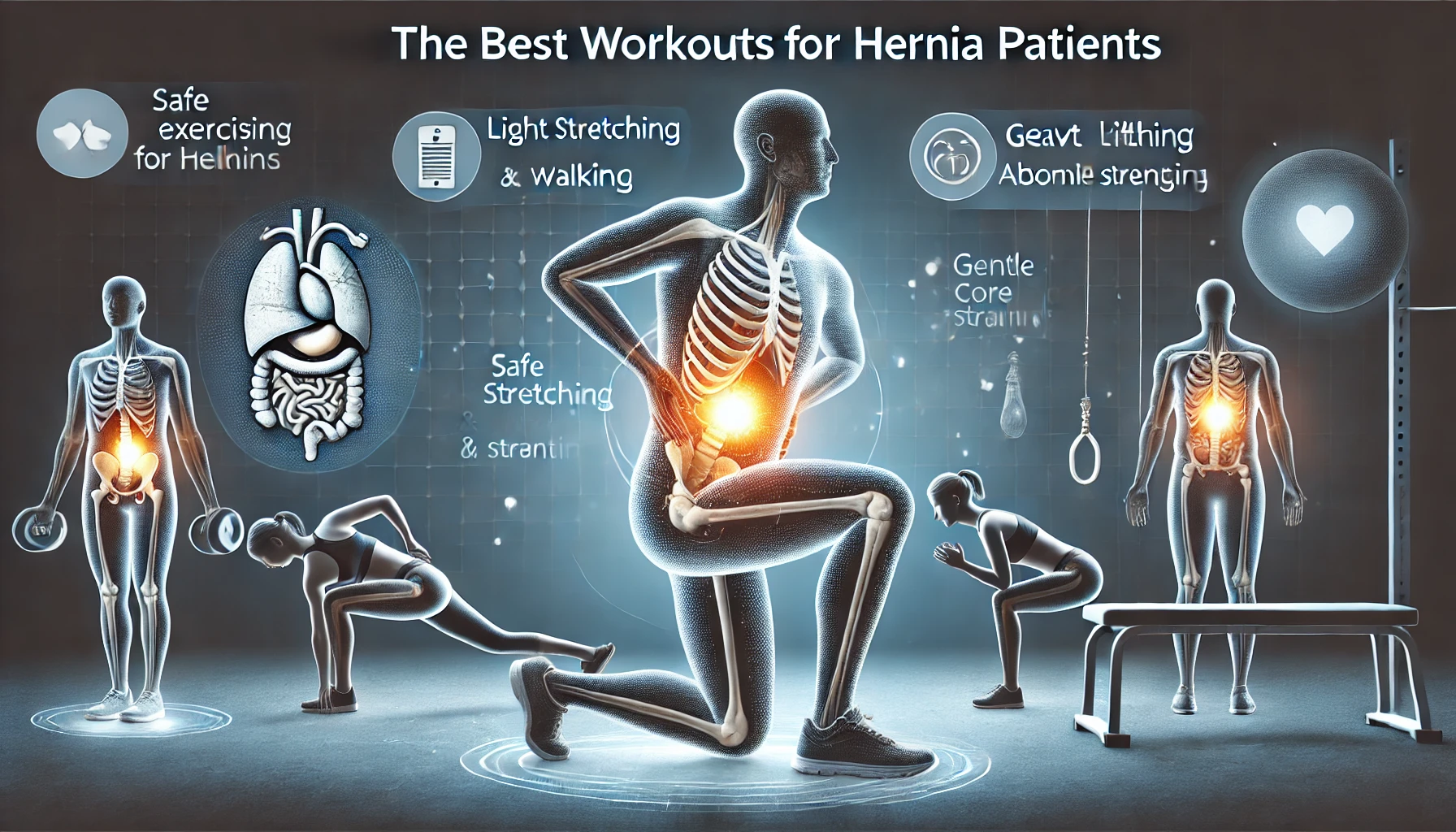Dealing with a hernia doesn’t mean you have to give up exercising altogether. In fact, staying active with the right types of exercises can help strengthen the muscles around the hernia and improve overall well-being. The key is to choose safe, low-impact workouts that won’t aggravate your condition or put extra pressure on the abdominal area.
In this blog, we’ll discuss the best workouts for hernia patients to avoid strain and injury. These exercises focus on gentle core strengthening, flexibility, and mobility, all while ensuring safety for those managing a hernia. Additionally, we’ll highlight the importance of hydration during these exercises, ensuring you stay healthy and well-hydrated throughout your workout routine.
Understanding Hernia and the Need for Safe Workouts
A hernia occurs when an organ or tissue pushes through a weak spot in the muscles, often in the abdominal wall. Hernias can cause pain, discomfort, and sometimes require surgery to repair. Whether you are post-surgery or managing the hernia conservatively, regular exercise can be beneficial for strengthening the muscles surrounding the hernia and preventing further complications.
However, not all exercises are safe for hernia patients. High-impact movements or exercises that increase intra-abdominal pressure can worsen the hernia or even lead to complications. The best workouts for hernia patients are those that focus on core stability and gentle muscle strengthening without placing stress on the affected area.
Best Workouts for Hernia Patients
Here are some safe, effective exercises designed to help hernia patients strengthen their muscles and avoid injury. These exercises target the core and surrounding muscles without putting undue strain on the abdomen.
1. Walking
Walking is one of the easiest and safest exercises for hernia patients. It’s a low-impact activity that helps improve cardiovascular health, boosts circulation, and engages the core muscles without adding strain to the abdominal area.
- How to Do It: Start with short walks of 10-15 minutes and gradually increase the duration as your strength and endurance improve. Aim to walk at a comfortable pace that doesn’t cause pain or discomfort.
Walking is a gentle exercise that promotes overall health and can be done daily without the risk of aggravating the hernia.
2. Swimming
Swimming is another excellent low-impact workout that works the entire body while being easy on the joints and muscles. The buoyancy of the water supports the body, making it an ideal exercise for hernia patients who need to avoid high-impact movements.
- How to Do It: Start with simple laps at a slow pace, focusing on controlled movements. Avoid strokes that involve excessive twisting of the torso, such as the butterfly stroke, and opt for gentler strokes like freestyle or backstroke.
Swimming helps engage the core muscles, improve cardiovascular fitness, and build overall strength without placing stress on the hernia site.
3. Pelvic Tilts
Pelvic tilts are one of the best core-strengthening exercises for hernia patients. This gentle movement engages the abdominal muscles without placing pressure on the hernia, helping improve core stability and support.
- How to Perform Pelvic Tilts:
- Lie flat on your back with your knees bent and feet flat on the floor.
- Tighten your abdominal muscles and tilt your pelvis upward, pressing your lower back into the floor.
- Hold the position for a few seconds, then release and repeat 10-12 times.
Pelvic tilts help strengthen the muscles around the hernia and are safe for hernia patients during recovery.
4. Bridge Pose
The bridge pose is a gentle core-strengthening exercise that targets the glutes, lower back, and core muscles. It’s a great way to improve muscle stability while avoiding strain on the abdominal area.
- How to Perform Bridge Pose:
- Lie on your back with your knees bent and feet flat on the floor.
- Press into your feet and lift your hips off the ground, forming a straight line from your shoulders to your knees.
- Hold the position for a few seconds, then slowly lower back down.
- Repeat 10-12 times.
The bridge pose helps build core strength without placing direct pressure on the hernia site, making it a safe option for hernia patients.
5. Seated Marching
Seated marching is a low-impact exercise that strengthens the core while providing support for the lower back and abdomen. This gentle exercise improves core stability without stressing the hernia.
- How to Perform Seated Marching:
- Sit in a chair with your feet flat on the ground.
- Lift one knee toward your chest while keeping your abdominal muscles engaged.
- Lower your leg and repeat with the other knee.
- Perform 10-12 repetitions on each leg.
Seated marching is an excellent option for hernia patients who want to strengthen their core without performing high-impact exercises.
For more exercises that are safe and effective for hernia patients, visit Best Exercises For Hernia Patients.
Exercises to Avoid for Hernia Patients
While it’s important to stay active, some exercises can worsen a hernia or lead to further injury. Hernia patients should avoid high-impact exercises that place excessive strain on the abdominal muscles. Exercises to avoid include:
- Sit-ups and Crunches: These exercises put direct pressure on the abdominal wall and can worsen the hernia.
- Heavy Lifting: Lifting heavy weights, especially over your head, increases intra-abdominal pressure and can aggravate the hernia.
- High-Impact Cardio: Activities like running, jumping, or intense aerobic exercises can stress the abdominal area and cause further discomfort.
- Twisting Movements: Exercises that involve twisting the torso, such as certain yoga poses or Pilates movements, can place strain on the hernia site and should be avoided.
It’s important to consult with a healthcare provider or physical therapist before starting any new exercise routine to ensure the movements are safe for your condition.
The Importance of Hydration During Hernia Recovery
Hydration is an essential component of any workout routine, but it’s especially important for hernia patients. Staying hydrated supports muscle function, aids digestion, and helps prevent complications related to hernia management. Dehydration can lead to constipation, which may worsen hernia symptoms due to straining during bowel movements.
Why Hydration Matters:
- Supports Muscle Function: Proper hydration helps muscles contract and relax efficiently, reducing the risk of cramps or strain during exercise.
- Aids Digestion: Drinking enough water promotes healthy digestion and prevents constipation, which can increase abdominal pressure and worsen hernia symptoms.
- Prevents Fatigue: Hydration helps maintain energy levels, allowing you to exercise more effectively and recover more quickly.
Be sure to drink water before, during, and after your workout to stay properly hydrated and support your body’s recovery.
Tips for Exercising Safely with a Hernia
To ensure you exercise safely and avoid injury, follow these tips:
- Start Slow: Begin with low-impact exercises and gradually increase the intensity as your strength improves.
- Listen to Your Body: Stop exercising if you feel pain, discomfort, or strain in the hernia area.
- Focus on Form: Proper form is essential to avoid injury and ensure that you are targeting the right muscles. If needed, work with a physical therapist to ensure you’re performing exercises correctly.
- Stay Consistent: Regular exercise, even if it’s low-impact, is important for maintaining strength and mobility. Stick to a consistent workout routine to support your recovery.
{For More Information Visit : https://empireadda.com/understanding-liver-diseases-prevention-and-care/}
Conclusion
For hernia patients, staying active and exercising safely is possible with the right approach. The best workouts for hernia patients focus on low-impact movements that strengthen the core, improve mobility, and promote overall health without straining the abdominal muscles. Walking, swimming, pelvic tilts, and bridge poses are all excellent choices that provide gentle support to the body during recovery.
Equally important is staying hydrated. Hydration supports muscle function, aids digestion, and ensures you have the energy needed to complete your workouts safely. Be sure to drink plenty of water throughout the day, particularly before and after exercise.



